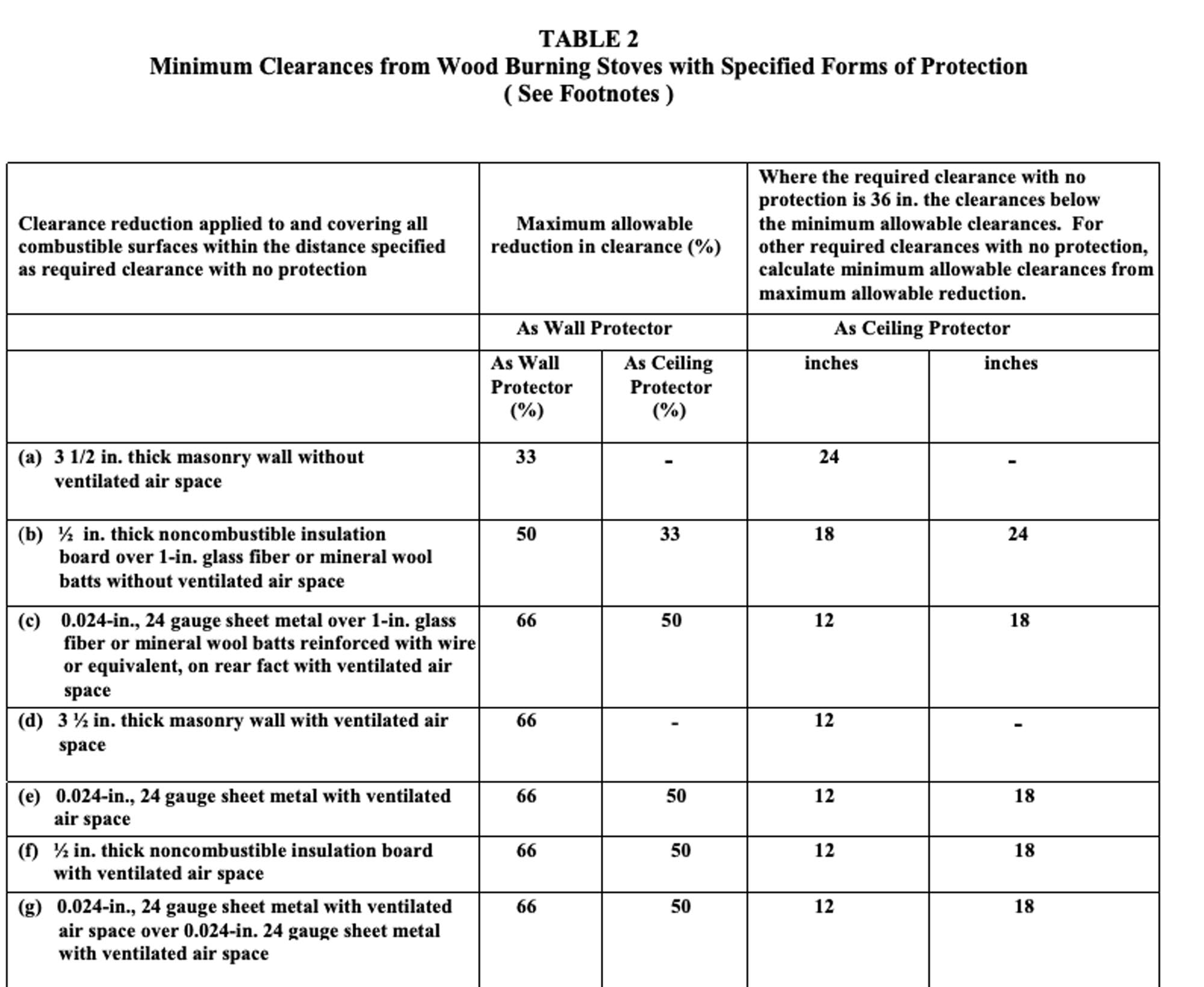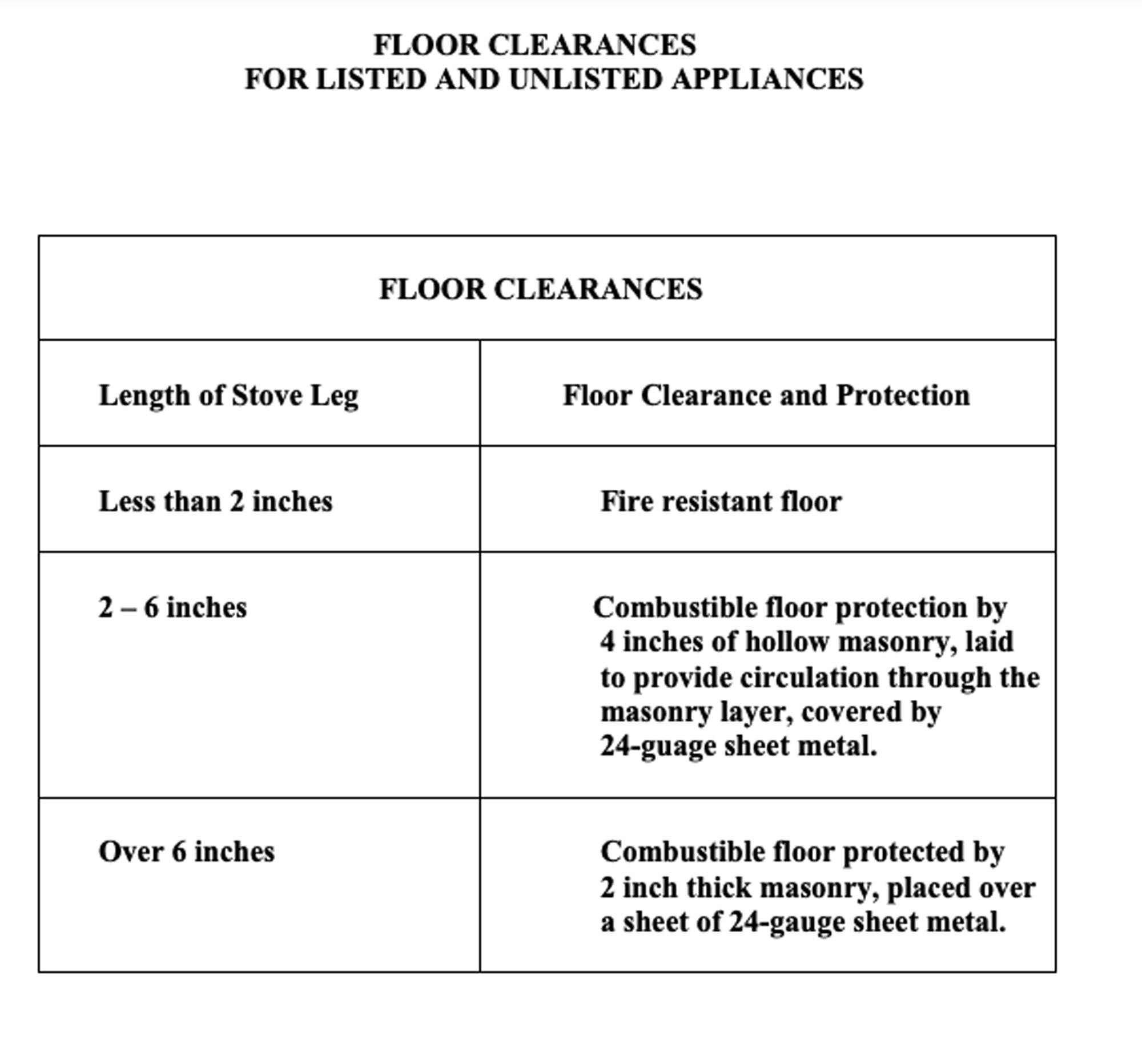Wood stove clearance is no laughing matter...even when I can't say it without giggling and quoting from Airplane: "Got the clearance, Clarance?" "Roger, Roger." "Set the Vector, Victor..."
But keeping heat from wood stoves away from walls, drapes, the cat, and other combustible material is vital for the prevention of house fires.
Failure to properly place your stove can nullify your insurance policy if a house fire does happen.
Understanding the variables in proper setbacks can often be confusing. So this article outlines the distances you should keep between your combustible materials and your wood stove.
Why Clearances Are Important
Clearances are important because they keep heat from wood stoves away from stuff that burns. This means that even if your family or home has a lot of combustible material, you can still install a wood stove safely as long as the proper air space is kept between the two.
Pyrolisis
Pyrolysis is the process of decomposing organic material by heat. It is "thermochemical depolymerization" and involves the simultaneous change of chemical composition and physical phase.
This means that heat, over time, compromised the integrity of materials, lowering their ignition temperature.
Thus, a combustible wall might be fine for a while, but after repeated exposure to radiate heat, could catch fire if left unprotected by a heat shield.
For more information on how lab testing determines these clearances, and on how best to set up your own wood stove at home based on manufacturer recommendations and NFPA code, please continue reading this article!
Who is NFPA?
NFPA (National Fire Protection Association) is a U.S. organization that develops codes and standards related to fire safety, including those for wood stoves. NFPA standards can be more stringent than the manufacturer's recommendations, so it's important to read up on both before installing a wood stove.
The major difference between the manufacturer's recommendations and NFPA is that NFPA requires greater clearance distances from combustible material, specifically for gas-fired stoves.
How manufacturers test wood stoves to determine clearances
A lot of people don't realize that there's a lot more to wood stove clearance than just the size and shape of the combustible material.
The type of venting system can also affect how much clearance you need, as well as whether or not your stove is vented to the outside. For instance, if you have an unvented gas stove, then the NFPA code requires greater clearances from combustibles (specifically for gas-fired stoves).
Lab testing determines these distances using set standards like this one - but it's still important to read up on manufacturer recommendations before installing your own wood stove!
Lab test methods for wood stoves
Lab testing for wood stoves to determine clearance distances can be done in a few different ways. One way to do it is by measuring the amount of heat generated from the stove. The other is by measuring how far away combustibles are from the stove when the stove is operating at various levels of intensity.
In general, the higher the heat level from the stove, the greater clearance you want from combustible material. But keep in mind that lab results tend to be for tests done on a metal fire box and that stoves with a different design may require a different set of clearances.
What it means for a wood stove to be "listed"
A wood stove is "listed" if it has been approved for use by the Listed Appliance Manufacturer's Association. Wood stoves that are listed have been safety tested and should have clearances according to the manufacturer's recommendations.

Vermont Castings Certification
For example, the picture below shows the wood stove installation guidelines for the Vermont Castings Defiant stove. It calls for a 21" wall clearance behind and beside the stove if installed parallel to an unprotected wall, but only a 5" wall clearance if installed in a corner.

Vermont Castings Defiant Clearances
If your model of stove is not "listed," then you should complete the stove installation based on NFPA codes.
How to find out if your wood stove is listed
It can sometimes be difficult to find out if your wood stove is "listed." The best way to find out is by looking at the owner's manual for your wood burning stove.
If your model of stove is listed, then you will see it listed as the "appliance certification."
write a paragraph explaining where to find your wood stove model number
NFPA Minimum Clearance
Combustible Wall "No Added Protection"
The NFPA clearance from combustibles is fairly conservative. As you can see from the table below, the code calls for a 36" air space between the stove and combustible walls for a radiant stove and 12" on the sides and rear of a circulating stove.
Radiant stoves are "single-walled" stoves, usually, cast iron or steel. Circulating stoves surround this single-walled thick steel or iron wall with a sheet of vented sheet metal, which functions as a heat shield.
Combustible Wall with "Specified Forms of Protection"
The table below shows that you can reduce clearances to combustible walls by adding wall protection like heat shields made from non-combustible materials.

From NFPA-based Maine Wood Stove Code
Heat shields work by creating a barrier between a combustible wall and a wood-burning appliance. This barrier is often sheet metal or a masonry wall. Note as well, that a heat shield uses an air space to dissipate heat away from the combustible surface provides a clearance reduction. (To read more about heat shields, check out my article here.)
Floor Protection
We've talked a lot about minimum clearances, but we should also address floor protection. When loading your "solid fuel-burning appliance" you will inevitably drop ashes or coals on the floor. Thus, protecting your combustible floor with some sort of hearth is a critical part of any wood stove installation.
The shorter the stove legs and closer to the floor the firebox is, the "stouter" the floor protection needs to be.
As you can see from the chart, if the stove legs are shorter than 2", you need a "fire-resistant floor" made from listed and approved materials (i.e fire-resistant insulating board).

Legs 2-6" require 4" of hollow masonry (the air space helps dissipate heat) covered by 24 gauge sheet metal, and over 6" only requires 2" of hollow masonry (also covered by 24 gauge sheet metal).
In addition, the hearth must extend "extend not less than 18 in. (457 mm) beyond the appliance on all sides."
Ceiling Clearances
Having dealt with walls and floors, we should tackle ceilings next!
For me, they're a bit of an afterthought since the NFPA code calls for 36." Most ceilings are 90" high, and most wood stoves are at most 48" off the floor. That gives you plenty of room.
However, if for some reason your stove sits higher, you will need to consider a sheet metal heat shield!
Chimney Connector
Chimney connectors carry flue gases from a stove, into a fire clay thimble connected into either a masonry chimney or some sort of metalbestes stove pipe.
Similar clearances exist for a chimney connector as walls...consider whether or not there is protection for the combustible walls.
With nothing to act as a heat shield, the chimney connector must have only non-combustible materials anywhere within 3 times the diameter of the connector. Thus, a 10" stove pipe requires at least 30" of space between it and other combustible materials.
Closing Thoughts
The tricky thing about clearances to combustible materials is that, although they are important, minimum clearances can vary from stove to stove. Plus, when you add the factors of clearance reduction based on heat shields...well...there are a lot of variables to consider.
Again, when in doubt, check with your local code enforcement officer. I have found most of them to be really helpful. Stop in, ask questions, and they'll offer solutions and insights that you may not have considered!
Be safe!
